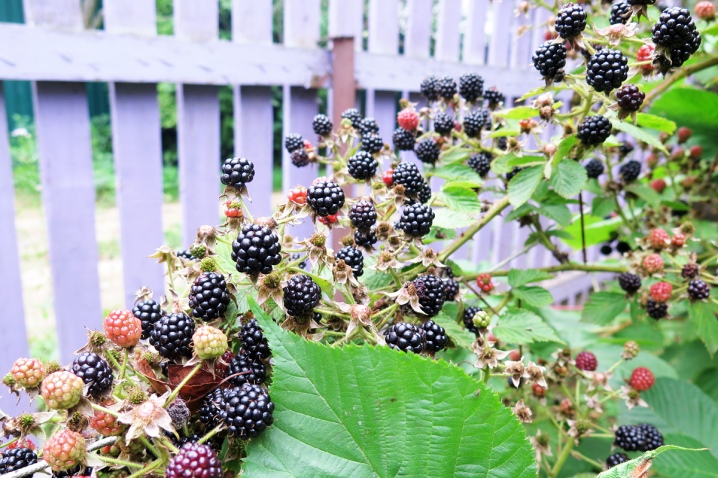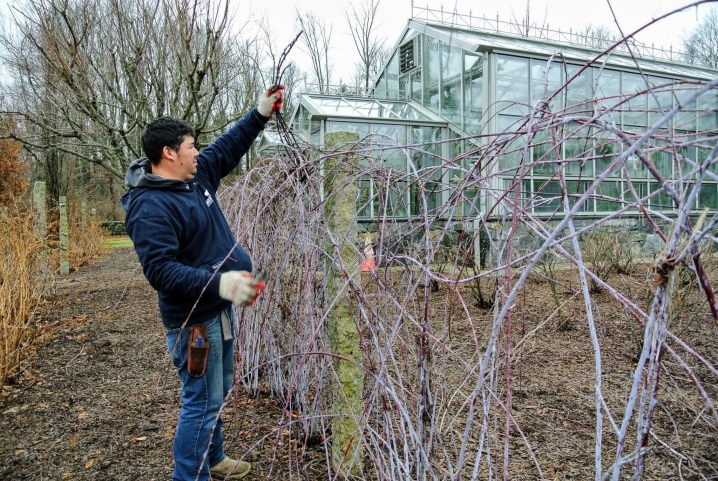How and when to prune blackberries in the fall?

Blackberries are a finicky berry that requires careful maintenance. She is not able to endure the harsh winter cold on her own. In order to enjoy its juicy fruits in the summer, you will have to learn the rules for pruning bushes.

The need for pruning
Gardening culture does not live long. In the first year, it grows and lays future fruit buds, in the second, the first flowers appear on the branches, and of them already berries. In the third year, the stems that have borne fruit become an extra burden for the culture, sucking out all the energy and nutrients from it. After getting rid of unnecessary ballast, the root system directs nutrients only to those stems that really need them. The branches that have already borne fruit should be cut off in the autumn, otherwise the bush will wither and wither.
Blackberries continue to bear fruit, even if they are not cut on time, but the harvest will be small.

Find out why you need to prune blackberries in the fall.
- The need for the direction of new shoots. Young stems should be guided by cutting off their tops in order to form the correct shape of the bush in the future.
- Broken or infected branches attract all sores. To avoid disease, such stems should be cut off.
- The more often you cut the tops of a bush, the more new fruit branches it grows. But that doesn't mean you have to cut every day.
- Old branches block the streams of direct sunlight, which is why young shoots do not receive enough solar energy and die.
- A plant that is too dense is weaker and more susceptible to disease. The overgrown bush in its ecosystem does not have time to carry nutrients to all the stems and gradually withers away.
- Blackberries grow very quickly. In height, the shoots can reach 2-2.5 m. If you do not cut it on time, you will have to spend money on insulation.

Preparing berries for winter is a rather laborious task. She should be looked after, and then she will give delicious "hedgehogs".
Timing
It is difficult to name specific dates, as they depend on many factors:
- the climate where blackberries grow;
- fertilizers used, planting methods;
- soil, terrain;
- berry variety (the ripening time of fruits differs in different types of blackberries).
The standard pruning time is September. This month, after hard days of work in summer, the berry is ready for winter vacation.
Sometimes gardeners do spring pruning by removing frozen stems and pruning young shoots.
In the Moscow region and central Russia, it is better to do the main pruning at the end of October because of the special climatic zone (moderately frosty winter, snow can fall as early as mid-October) in order to catch the cold weather.

Schemes for beginners
In order to properly prune a garden blackberry, you need to determine its age and type. The very first pruning should be done during planting: the root network is deepened 2–4 cm into the ground and the stems are cut at a height of 25–35 cm from the ground. At a bush in the first autumn, the stems are shortened with a garden shears or a hacksaw up to 1.5 meters.
The rods on which the berries were located have a brownish-brown tint, they need to be cut off with special equipment.

Forming old bushes
If the bush has already taken root and bore fruit in the second year, then sanitary pruning is carried out in the fall.
Removal of fruiting shoots from the root. You can not leave a "stump" from the old stem, then it will start to rot from moisture.
We leave the strongest and strongest branches, cut out the rest. This will distribute the nutrients evenly among all the stems.
We also cut off young shoots that are not sufficiently ripe.
Removal of dry, diseased, thin and weak branches. They only take away energy.

As for the correct formation of the old bush, the plant is attached to the trellis in a fan-shaped way. After winter, the remaining lashes are distributed in the center, and young shoots - on the sides, while tilting them slightly to the side. The entire structure is attached to horizontal supports.
In the fall, the central part is cut off at the root. Young shoots that have already grown are removed, leaving ten of the strongest ones. They are shortened by 20 cm just above the kidney discharge. After that, the young stems are bent to the ground and covered for the winter, and in the spring they are closed to the center, giving the young shoots space. And all over again!
Before shortening the young stems, they are covered with garden varnish or a layer of mastic to disinfect them.

So, once again about the formation of a bush:
- branches on a support (trellis) are placed 25-30 cm from each other;
- branch length - no more than 2 meters;
- the berry is on the sunny side;
- no more than 10 fruiting shoots on one bush.

Pruning depends on the type and variety of blackberries.
Climbing blackberry (another name is creeping) reaches a length of 5 meters. It creeps because its branches cover the whole earth, covering it and braiding vertical surfaces. Therefore, support is needed to form such a bush.
The lashes are divided into two parts: one - with the wintered, the second - with the young.
Both parts are screwed onto a vertical support. Excess branches are also removed in the spring at the bend, and in the fall, only old stems.

Young branches are untied, the most flimsy are cut off and the remaining ones are folded into a circle;
Placed on wood or straw, treated with copper sulfate (prevents infection and the appearance of pests);
They are laid for the winter, pressing to the ground (its branches are flexible, and for such a variety it is not difficult).
The procedure is repeated next year.

Curly blackberries are distinguished by the fact that their stems are weak and thin. It is grown only with the help of supports. When, in the spring, the central old part is separated from the young shoots, they are tilted to the side and attached to the trellises (support). In autumn, 14-15 annual branches are left, and in spring - 10.

For young blackberries
Caring for young shrubs is no different from caring for old ones. Only on old bushes leave up to 10 strong fruiting branches, and on young - 3-4 stems. This will distribute nutrients evenly and reduce the risk of plant thickening.

For thorny and thornless plants
For thornless plants, in addition to autumn sanitary and main pruning, spring and summer are required, as a result of which damaged or infected branches are removed. In summer, the tips of young shoots should be trimmed by 100–110 mm - after the stems have grown by 1100–1200 mm. But this is for untied stems, and if the shrub was originally attached to the support, then the top is pruned when the branches have grown 200–210 mm above the support.
Pinching is the regular pruning of the tops of young stems.
After pruning the tips of the branches, laterals appear on the annual stem - lateral shoots, which must be maintained at a level of 400–440 mm to reduce the risk of overgrowth, leading to darkening of young shoots without the possibility of sunbathing.
When the crop is harvested, in September - November, two-year-old stems are cut to the root (again, no stumps), covered with a film from the subsequent cold weather.

Blackberries with thorns (kumanika or bushy blackberries) have erect stems, but over time they tend to bow sideways, which is why gardeners attach them to the trellises in a fan-shaped way (the center consists of old branches, on the sides - young shoots). It is quite frost-resistant, but to prevent frostbite, it is better to protect it in the following ways:
- build a "hut" around the bush of metal rods or wood sticks, cover with agrofibre, then on top with a film;
- branches are covered with spunbond or lutrasil, attaching to the ground from the wind;
- without removing the trellis, the shrub is covered with agrofibre and fixed to the ground;
- the berry is covered with straw, dry branches of reeds or spruce branches, a non-woven material is placed on top of the structure to circulate air between the layers;
- branches are covered with dry leaves of corn, on top - dense polyethylene.

Blackberry varieties are frost-resistant and not (usually they are thornless bushes). But depending on the place of its growth and the climate of the area, it should be understood whether it is necessary to shelter for the winter or not.
Follow-up care
In the fall, the shrub is not only cut off, but also several manipulations are carried out to prepare for the winter period. When the stems are cut and the foliage has fallen, all debris should be collected and taken out, as pests can get from it on a healthy plant.

Top dressing is different.
- Superphosphate (50 grams per m2).
- Potassium sulphate (25 grams per m2).
- Manure (spread out side by side with a thickness of 10 cm).
- Wood ash. After burning wood, the remaining ash is brought under digging (1 glass of ash is enough) or fertilizer is made (mix ash with water, leave for a couple of hours and pour the soil with the resulting solution).
- Moisture charging irrigation - a procedure that does not require any fertilizers, you can feed the plant with plain water. Before the winter cold, if autumn is dry and does not indulge in rains, moisture-charging irrigation will help the root system of the plant: 20 liters for each plant is enough. A hose with a small pressure of water is sometimes left next to the berry. So you don't have to constantly monitor the level of soil moisture.
- Compost. Can be made at home from fallen leaves, tops, sawdust, peat, eggshells, etc. The resulting mass is piled into a compost heap, poured with water until completely saturated and left to peat.
- Bird droppings. It is saturated with nitrogen, therefore it is used only in rotted form in small quantities for digging.
- Humus. About humus as fertilizer separately. It should be added to the soil systematically: once every 3 years. Then the shrub will receive adequate nutrition. It creates a loose layer that allows you to retain moisture in the soil and protect it from drying out.
Nitrogen fertilizers should not be applied before winter laying, as they promote the growth of new shoots, which is undesirable before cold weather.

After feeding the plant with the necessary fertilizers, the soil should be loosened so that all substances penetrate deeply to the roots.
Regular fertilization will increase yields and protect your garden crop from pests and diseases.
Of course, a well-formed bush will decorate your garden, but autumn pruning carries more meaning than just decoration. Thanks to her, the blackberry berry will not suffer from diseases and insect pests, and young shoots will have the opportunity to grow quickly and in the future will delight the gardener with a harvest.














The comment was sent successfully.